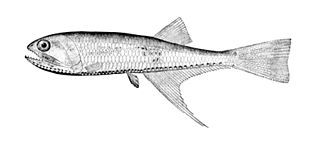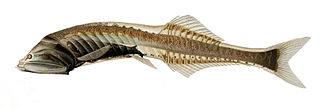 W
WThe Gonostomatidae are a family of mesopelagic marine fish, commonly named bristlemouths, lightfishes, or anglemouths. It is a relatively small family, containing only eight known genera and 32 species. However, bristlemouths make up for their lack of diversity with numbers: Cyclothone, with 13 species, is thought to be the most abundant vertebrate genus in the world, numbering in the hundreds of trillions to quadrillions.
 W
WBonapartia pedaliota, the longray fangjaw, is a species of bristlemouth found in the Atlantic and Indian Oceans. It is the only described species in its genus. This species grows to a length of 7.2 centimetres (2.8 in) SL.
 W
WBonapartia pedaliota, the longray fangjaw, is a species of bristlemouth found in the Atlantic and Indian Oceans. It is the only described species in its genus. This species grows to a length of 7.2 centimetres (2.8 in) SL.
 W
WCyclothone is a genus containing 13 extant species of bioluminescent fish, commonly known as 'bristlemouths' or 'bristlefishes' due to their shared characteristic of sharp, bristle-like teeth. These fishes typically grow to around 1-3 inches. They are most commonly found in the mesopelagic zone of the ocean, and are mostly found at depths of over 300 meters.
 W
WGonostoma is a genus of bristlemouths.
 W
WMargrethia is a genus of bristlemouths.
 W
WMargrethia obtusirostra, the Bighead portholefish, is a bristlemouth of the family Gonostomatidae, found in the tropical and subtropical Indo-Pacific and Atlantic oceans, at depths of between 100 and 600 m. Its length is between 5 and 8 cm.
 W
WSigmops is a genus of bristlemouths.
 W
W